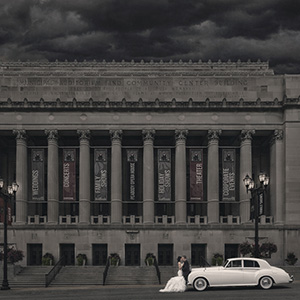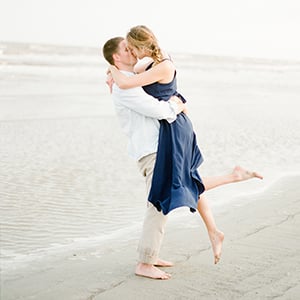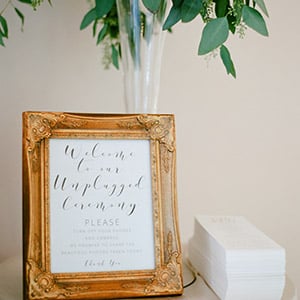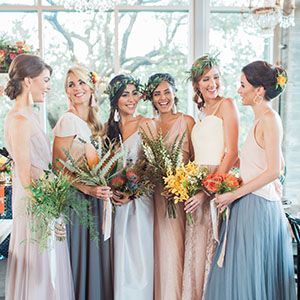6 Smart Flower Buying Tips
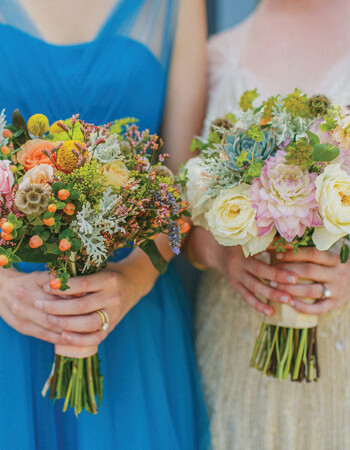
Photo: Daniel C. Photography - Flowers: Flora & Eventi
Heading into your first consultation with a floral designer is enough to make your head spin. Between distinguishing your freesia from your phalaenopsis, to figuring out whether to go high, low or somewhere in the middle with your centerpieces, purchasing your wedding-day petals can be a lot more complicated than it sounds.
Fortunately, we wrangled five fabulous floral and design experts who know the wedding floral scene from stem to stamen, and asked them for their best flower-buying tips.
1. Go with a pro.
To ensure superior floral quality, it’s essential to hire a reputable florist with exclusive access to the finest growers and distributers worldwide. “The costs of arranging flowers yourself versus hiring a professional really balance out,” adds David Tutera, New York-based celebrity florist and the face of weTV’s “My Fair Wedding with David Tutera.” “Though you’ll have to pay for labor when hiring a professional, they likely will have access to wholesale costs for the flowers, which will be cheaper than what you’ll be able to buy yourself.”
Truthfully, on your wedding day, the last thing you’ll want to do is fret about your flowers. You don’t need that stress, nor will you have the time to create fresh, professional-looking floral arrangements in the last few days—or even hours—leading up to your wedding. Aside from event decor, a floral expert knows how to construct a bouquet and boutonnieres, “which is not easy,” Tutera says. “And most importantly, they are knowledgeable about how and when to use blooms that will continue looking fresh throughout your wedding.”
2. Take to the fields.
Rustic, homegrown ceremonies have become popular, and with them has grown the popularity of tousled, natural-looking flowers. If you’re getting married in a town with plentiful wildflowers, there’s no harm in going to pick your own blooms, especially for accent flowers, or to feature in vintage vignettes—say, on your guestbook table alongside framed family photos. They’re free (or close to it) and bring a local feel to your celebration.
“Instead of doing tall or high round arrangements, do small clusters of arrangements that have a few (local) flowers in them,” says Shondra Cheris, event designer with Washington-based Livewire 99.
While small, DIY wildflower touches are charming, it’s best to leave complex arrangements such as your bridal bouquet to a professional. To keep your overall floral look unified, ask your florist to incorporate a few local or wild blooms.
3. Buy in bulk.
This doesn’t mean making a trip to a big-box store. Rather, if you have an overall theme or design scheme in mind for your ceremony and reception, and you’re willing to limit the variety of flowers you use, “purchasing larger amounts of fewer types of flowers can save you money,” Tutera notes.
4. Splurge here, save there.
When working with a budget, it’s important to determine what floral elements are essential to your wedding experience. Again, your bouquet is one place to allocate ample funds. “The bride should never be conservative on her bouquet,” says Jerri Powell, director of sales for Houston-based Darryl & Co. “This, after all, is a precious gift from her groom and of immeasurable value.”
While bridesmaid bouquets are a great way to show your girls your gratitude, and add a pop of color to your altar, they can be scaled back considerably in comparison to the bridal bouquet, says Sheli Hart, event designer for Houston’s Flora & Eventi. Flowers for the bridesmaids and rest of the bridal party “should suit the theme, but can definitely be a more cost-effective option,” she says.
Large floral statements, too, are another floral area you should fund amply—but smartly. Notes Todd Fiscus of Todd Events, with offices in Dallas and Houston, “One of my favorite design elements, is to create two amazing, huge—as in smart-car-sized—florals, on pedestals, and then surround them with tables with candles and gardenia details. The room will feel fresh as opposed to all tables getting the same thing.”
5. Get savvy about seasonals.
Being stubborn in your floral selections will ultimately lead to a hefty bill. If you want winter flowers in summer, or summer flowers in winter, prepare to take on the cost of importing blooms from exotic locales, where the seasons are reversed—and understand that flowers that have to travel far may not be at the peak of freshness on your wedding day.
Instead, it’s usually a good idea to use at least a significant portion of seasonal blooms in your personal flowers, as well as ceremony and reception arrangements, says Stacy Mendenhall, owner of Lary’s Florist and Designs in Friendswood. For example, though you might want spring tulips in your winter ceremony, you can add season-appropriate greenery and juniper boughs for a playful floral duality.
“Find out what is going to be in season and plan around that,” Tutera says. “There are many flower varieties that work all year long, such as roses and hydrangeas. These can be mixed and matched in corresponding colors with what will be in season around the time of your big day, to build lush and textured arrangements. But the seasonal varieties should take center stage to highlight their timely beauty.”
6. Think beyond the bloom.
Thanks to the rise of the Pinterest-sphere, creative ideas for alternatives to traditional exotic floral varieties—many of which create the same warm, romantic feel of from-the-garden varieties—are becoming more widespread and innovative. For large-scale floral decor—think chuppah, mandap or altar—carnations, hydrangeas, basic roses and even intricately folded paper flowers can be used to create volume and abundance, especially in areas that are farther from the guest’s eye.
Meanwhile, the shimmer of metallics (mercury-glass vases, gold candlesticks, silver julep cups) and the sparkle of glass and crystal (votive holders, beaded strands, brooches and gems) provide the perfect contrast to offset natural, dewy petals and leaves, and give arrangements a special-occasion feel. And lastly, experts recommend incorporating fruit, succulents, greenery and, of course, plenty of candles, to add texture, contrast, vintage elegance or modern edge to your wedding flowers.

